
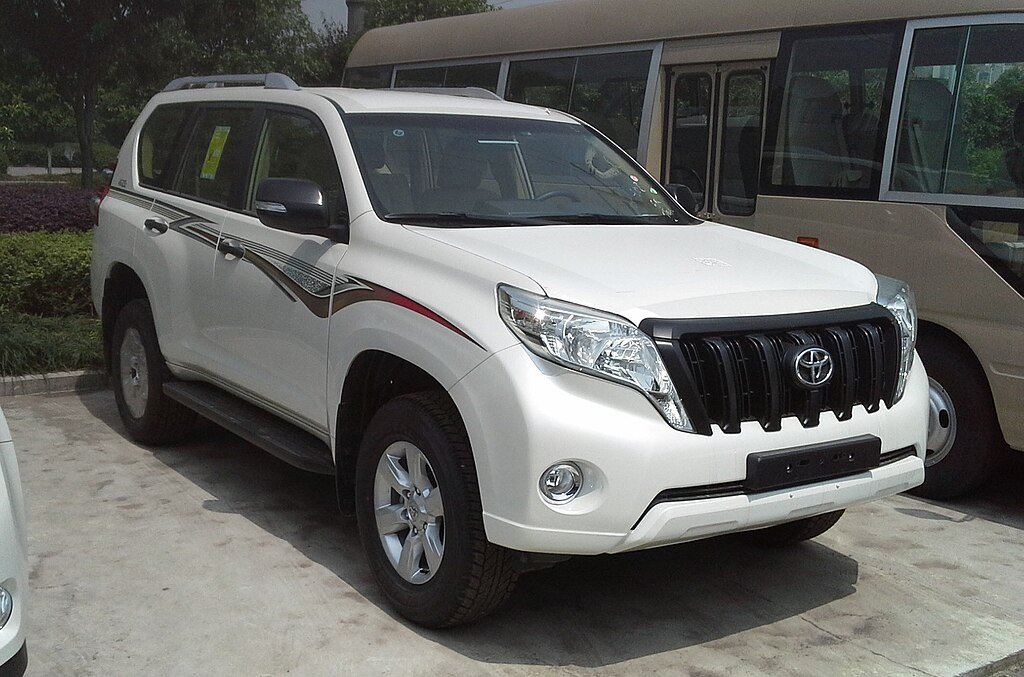
The Ultimate Family SUV? A Review of the Toyota Prado J150
Is the fourth-generation Prado (J150; 2009–2023) still the best all-round family SUV for Kenyan roads in 2025—now that the all-new J250 has arrived? Short answer: for most families who value durability, true 4×4 hardware, and nationwide support, the J150 still hits a very sweet spot. The long answer (below) dives into trims you’ll actually find in Kenya, what to check on a used import, and how it stacks up against the Ford Everest, Isuzu MU-X, and Mitsubishi Pajero Sport.
Table of Contents
ToggleTL;DR (for busy parents)
- Who it suits: Families who need real 4×4 capability plus seven seats for school runs, weddings upcountry, and weekend trips to Naivasha, Nanyuki, or the Coast.
- Why it works in Kenya: Stout ladder-frame chassis, full-time 4WD with low-range, generous ground clearance and factory wading ability, and Toyota’s extensive CFAO dealer network.
- Big upgrades to know: In 2020, the 2.8-litre diesel got a healthy power/torque bump and the infotainment gained Apple CarPlay/Android Auto on many trims.
- Trade-offs: Heavier steering and more body roll than car-based SUVs, older ADAS on earlier years, and a side-hinged tailgate that can be annoying in tight parking (though some cars have a handy flip-up rear glass).
- Today’s context: The newer J250 launched locally in 2024 (from about KSh 17.5M new), but the J150 still dominates the approved-used market and offers outstanding value.
What exactly is the J150?
The J150 is the “light-duty” Land Cruiser Prado generation sold globally from 2009 to 2023 (five-door being the family favourite). It sits above Fortuner and below the full-fat Land Cruiser 300, keeping body-on-frame toughness, low-range gearing, and space for a true third row. In 2023/2024, Toyota unveiled the J250 successor, but J150 remains the most common Prado you’ll find new-old-stock or approved-used in Kenya.
Trims & engines you’ll actually see in Kenya
Common grades in our market: TX / TX-L (core spec), VX (luxury), and VX-L/Kakadu (range-toppers with more off-road toys). These grade names are pervasive in East/Southern Africa and among Japanese imports, so you’ll see them frequently in Kenyan listings. Always verify exact equipment on the individual car.
Powertrains you’ll encounter:
- 2.8-litre turbo-diesel (1GD-FTV) – From 2015 globally; 2020 update lifted outputs to 150 kW/204 hp and 500 Nm, paired to a 6-speed auto. It transformed highway response, towing confidence and overall drivability.
- 4.0-litre V6 petrol (1GR-FE) – Smooth, simple, and thirsty; widely seen in imports and some Africa specs, typically around 202 kW/271 hp.
- Earlier 3.0 D-4D (1KD-FTV) – Common on 2010–2015 cars. Robust and torquey, but noisier and older emissions tech than the 2.8.
Drivetrain tech you want to know: Full-time 4WD with a lockable centre diff and low-range is standard Prado DNA; many higher trims add a locking rear diff, Crawl Control, Multi-Terrain Select, and KDSS (hydraulic sway-bar system that calms body-roll on road yet frees articulation off-road).
Exterior & daily practicality (city + shamba)
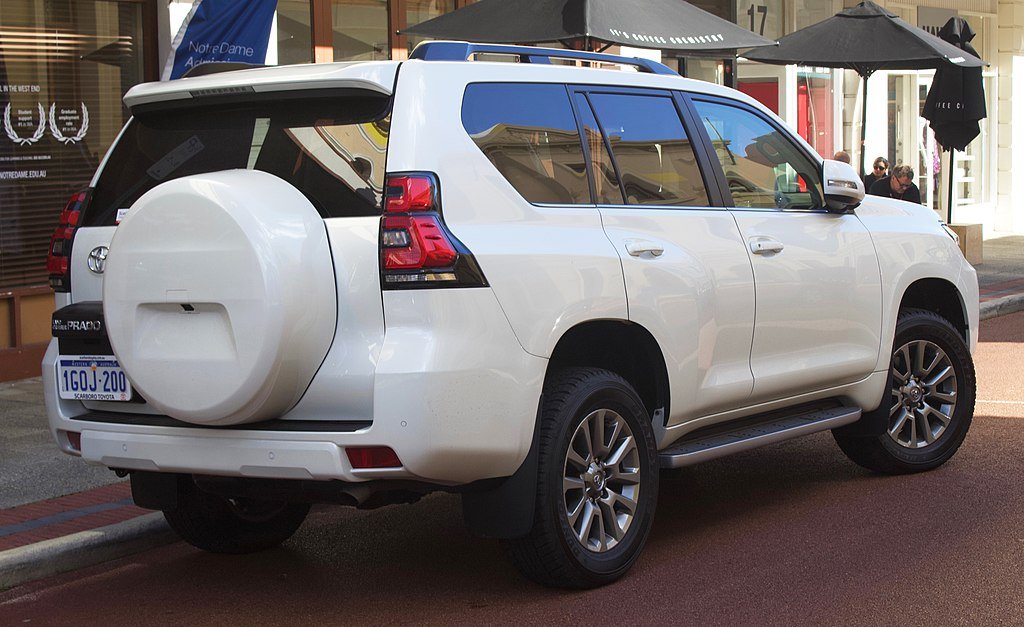
The good: The Prado’s upright glasshouse gives superb visibility for matatu-heavy streets and rural B-roads. The spare-on-door look keeps approach/departure angles honest; and later models offer LED headlights on upper trims (worth it if you drive Nairobi–Naivasha at night). Factory turning radius for the 5-door is about 5.8 m—respectable for a big 7-seater.
The watch-outs: The classic side-hinged tailgate can be a pain in tight mall parking. Many cars have a flip-up rear glass hatch, perfect for tossing school bags or shopping in without swinging the whole door; some markets also offered a “flat tailgate pack” (vertical liftgate with glass window) but that package affects the fuel-tank setup (more in Section 9).
Cabin, kids’ seats & cargo
Seating & space: The five-door J150 came in both 5- and 7-seat configurations. The second row slides/reclines on most trims, and the third row is perfectly fine for kids or shorter teens on medium trips (Nyeri, Naivasha) but adults won’t love it for long hauls.
Child-seat friendliness: Two ISOFIX/LATCH points outboard in the second row are common, plus top-tethers—do a hands-on fit with your specific seats (three across with boosters is doable but tight). Tall windows mean great sightlines to keep an eye on the back seats.
Cargo: With all seven seats up, boot space is modest; with row three folded, the load bay is long and flat. UK-spec figures give a sense of the packaging and turning circle, though exact litre numbers vary with seating and spare-wheel options.
Infotainment & connectivity (CarPlay/Android Auto)
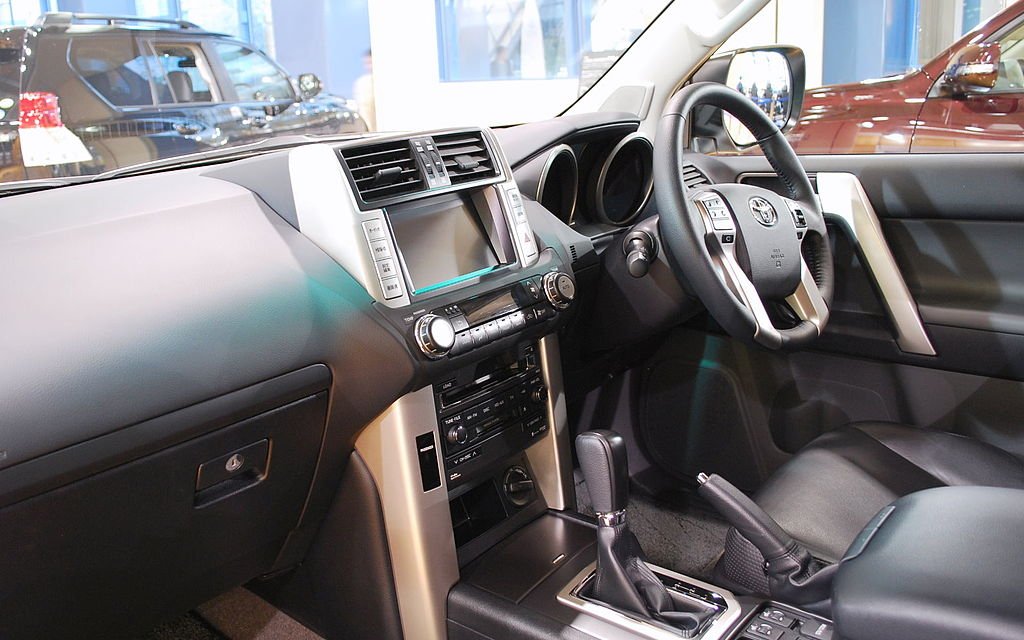
Early J150s feel old-school (small screens, basic Bluetooth). From August 2020, Toyota rolled out an **upgraded multimedia system with quicker software and Apple CarPlay/Android Auto on many trims/markets—be sure to check the actual head unit on any Kenya-bound car or used import. If your specific vehicle didn’t get it, retrofit solutions are widely available.
Safety & driver assistance
The reality for Kenya: Stability control, traction control, multiple airbags and trailer sway control are widespread, but advanced ADAS (autonomous emergency braking, lane-keeping) were limited on many earlier J150s. If you want the latest assistance features—and lighter electric steering—test the new J250, which adds modern electronics and EPS as part of its redesign.
On-road comfort & performance
Ride & steering: Expect a relaxed, slightly “floaty” feel over bumps; that body-on-frame comfort is excellent on corrugations and speed bumps. KDSS (where fitted) makes the Prado feel more tied-down without ruining off-road flex.
Engines:
- The updated 2.8 diesel (from 2020) is the Kenya sweet spot—strong 500 Nm shove makes altitude climbs and loaded family trips feel effortless.
- The 4.0 V6 petrol is ultra-smooth and simple to maintain, but consumption rises in city traffic.
Noise: Diesel clatter at idle is normal; at 100 km/h conversation is easy, with tyre choice making a big difference.
Off-road & towing (real-world Kenya)
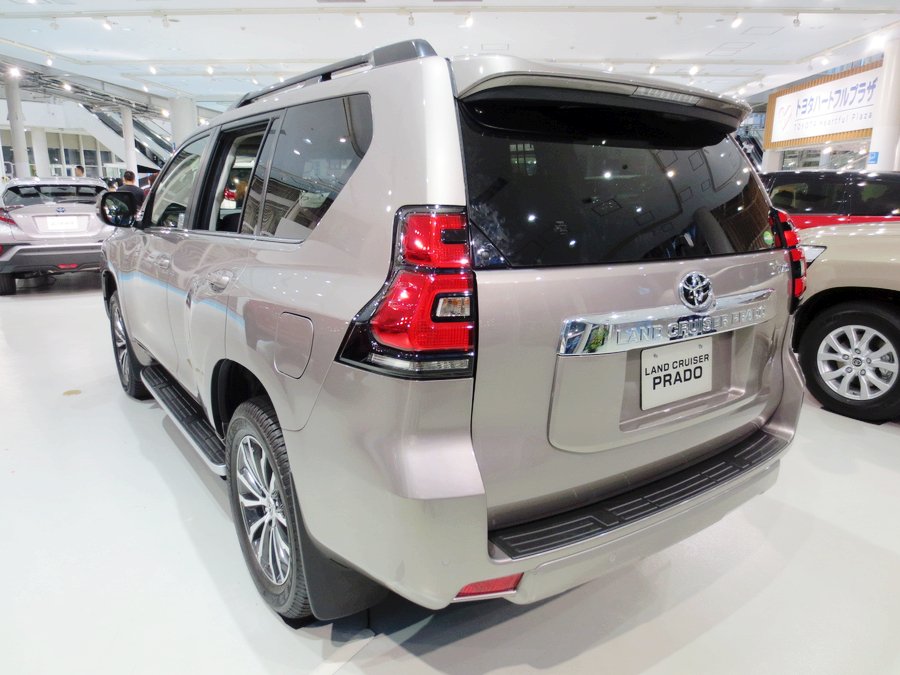
This is where the Prado earns its stripes. Beyond the usual 4×4 hardware, the factory spec sheet quotes 700 mm wading, sturdy approach/departure angles, and 3,000 kg braked towing (region/year dependent—check your VIN/door sticker). On Kenyan river crossings and muddy rural roads, that wading figure isn’t just brochure fluff; it’s peace of mind.
If you plan to tow a boat or double-axle trailer regularly, the post-2020 2.8 diesel is the pick thanks to the torque bump and improved gearbox tuning.
Fuel economy, range & diesel quality
Typical consumption (real owners):
- 2.8 diesel: 8–10 L/100 km on highway cruises; 11–12 in mixed Nairobi use.
- 4.0 petrol: low- to mid-teens, depending on traffic and tyres.
The big range advantage: Many J150s in our region run twin tanks totalling ~150 L (87 L main + 63 L sub-tank), good for Coast runs without refuelling. Cars with the flat tailgate pack (spare underfloor) often lose the sub-tank, dropping capacity to 87 L—plan your stops accordingly.
Kenyan diesel quality (DPF-friendliness): The EAC adopted a 50 ppm sulphur diesel standard, and Kenya Pipeline data over recent years has shown imported diesel averaging ~10 ppm, which is excellent for modern DPF-equipped diesels. EPRA/KEBS continue to police fuel quality (including clamping down on high-sulphur export-grade misuse), but the base standard is DPF-friendly.
Ownership costs, reliability & resale
Service & parts: Toyota/CFAO’s footprint and parts pipeline are the Prado’s secret sauce in Kenya—genuine parts availability, trained technicians, and predictable service intervals.
Reliability: The J150 has a well-earned reputation for longevity (particularly chassis/driveline). As with any diesel SUV used mainly for short hops, mix in weekly longer drives to keep the DPF healthy; petrol V6s suit low-mileage city users who want to avoid diesel after-treatment altogether.
Resale: Consistently strong—one reason Prados hold a premium on the used market.
Model-year guide (what to target used)
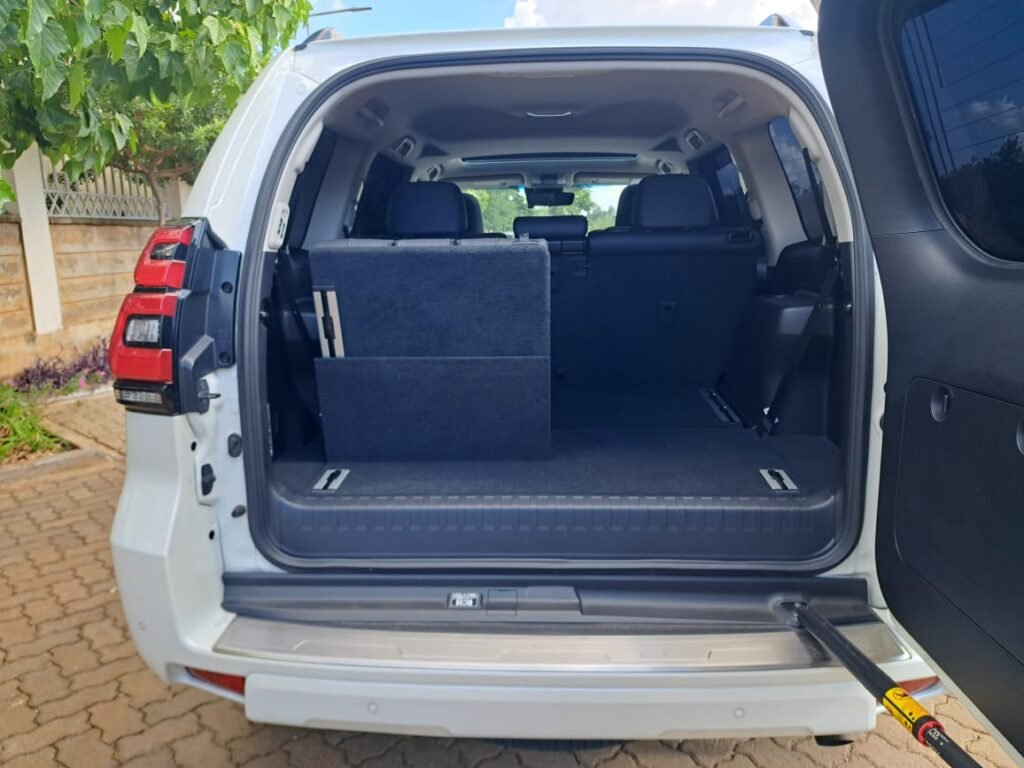
- 2010–2013 (early): Basic infotainment; common engines are 3.0 D-4D or 4.0 V6.
- 2013 facelift: New front fascia, improved equipment.
- 2015–2019: Introduction of the 2.8 GD diesel in many markets.
- 2020 update: The sweet spot—150 kW/500 Nm diesel plus infotainment with CarPlay/Android Auto on many trims.
- 2023–2025: Transition to the J250 (new model), but J150 dominates approved-used stock.
Our Kenya pick: 2018–2022 2.8-diesel autos (post-2020 if budget allows) or a pampered V6 petrol if your driving is mostly short urban trips.
Used-buy checklist: Full service history, proper 4×4 operation (centre/rear diff locks), suspension bushes and shocks, underbody inspection for off-road scrapes, and DPF health (diesel).
Competitors to test-drive in Kenya
If you’re cross-shopping, these are the realistic alternatives you can find with official dealer support:
- Ford Everest – Modern cabin and ADAS, relaxed highway road manners; officially sold by Caetano/Ford Kenya.
- Isuzu MU-X – 1.9 L or 3.0 L diesels, ladder frame, huge Isuzu service presence countrywide.
- Mitsubishi Pajero Sport – Capable, often better upfront value, smaller dealer footprint than Toyota/Isuzu.
Why Prado over these: Proven durability, parts ubiquity, rock-solid resale, and—on many units—the long-range 150 L dual-tank setup. Why a rival instead: Fresher infotainment/ADAS (Everest), lower upfront price (MU-X/Pajero Sport).
Buying advice (Kenya-specific)
Trim strategy:
- TX/TX-L – Value play for families that want the essentials.
- VX – The comfort sweet spot for most.
- VX-L/Kakadu – For enthusiasts who want the full off-road tech suite (KDSS, sometimes air suspension). Specs vary by origin, so confirm per vehicle. toyotakenya.ke
Diesel vs petrol (how to choose):
- Mostly short, urban trips (school run, CBD): Consider the 4.0 V6 petrol, or commit to a weekly 30–40 min highway run to keep a diesel’s DPF happy.
- Regular highway, towing, upcountry: 2.8 diesel, especially 2020+ with 500 Nm.
Fuel tanks & tailgate choice: If long-range touring matters (Mara, Turkana), prioritise cars with the 87 L + 63 L (150 L total) setup. “Flat tailgate pack” cars typically have 87 L only—fine for everyday Kenya use, but plan fuel stops on remote routes.
Where to buy & service new: Toyota in Kenya is represented by CFAO Mobility (formerly Toyota Kenya). If you want the latest J250, CFAO launched it in 2024; list prices at launch were reported around KSh 17.5M depending on grade/options.
Verdict & scores (Kenya-family lens)
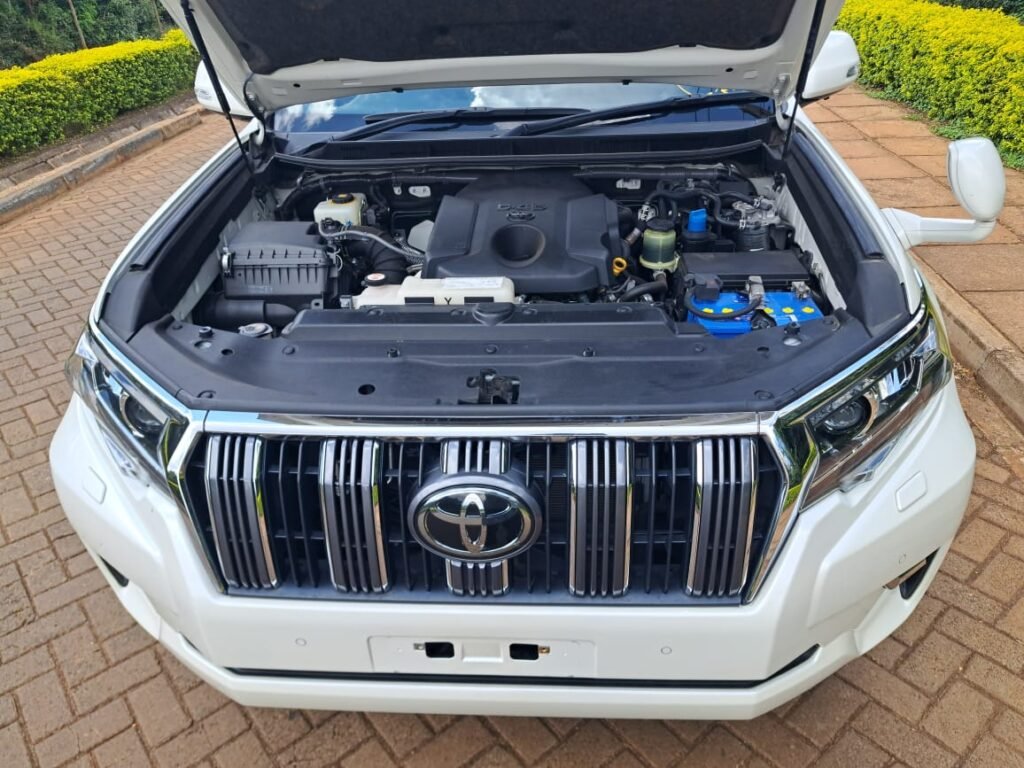
Verdict: If your family adventures toggle between Nairobi’s school runs, Naivasha or Nanyuki weekends, and the odd muddy shamba road, the J150 is still an outstanding choice. It’s not the last word in slick tech or feather-light steering, but it is the last word in go-anywhere dependability, range, and residual value here. If you want the very latest ADAS and a newer interior, test the J250 and Ford Everest back-to-back—then decide.
Scores (out of 10):
- Cabin/practicality 8
- Safety/ADAS 7 (varies by year)
- Tech/UX 6–7 (better on 2020+)
- Performance 8 (2.8 diesel 2020+)
- Comfort/NVH 8
- Off-road 9
- Towing 8
- Efficiency 7 (diesel) / 5 (petrol)
- Value 8
- Ownership 9
FAQs (Kenya-focused)
Is the third row comfortable for teenagers? For short/medium trips, yes. For long highway stints, it’s better for kids. Try before you buy.
Can three child seats fit across row two? Two ISOFIX seats plus a narrow booster in the centre is workable, but test your exact seats in the car you’re buying.
Does the 2020 update really make a difference? Absolutely. The 2.8 jumps to 150 kW/500 Nm and the infotainment supports Apple CarPlay/Android Auto on many trims. It feels much brawnier at altitude and when loaded.
How deep can the Prado wade? Factory 700 mm (check your tyres and approach carefully).
What’s the real towing comfort at Kenyan highway speeds? The post-2020 2.8 is your friend; the extra torque plus trailer-stability control inspires more confidence.
Is Kenya’s diesel OK for modern DPFs? Yes—EAC standards cap sulphur at 50 ppm, and imported batches have averaged around 10 ppm in recent years per KPC/UNEP notes, which is DPF-friendly.
Key specs at a glance (family & adventure)
- Drivetrain: Full-time 4WD, low-range, centre diff lock; rear diff lock/KDSS on higher trims.
- Wading depth: 700 mm (factory).
- Towing (braked): Up to 3,000 kg (market/spec dependent).
- Turning circle: ~5.8 m (5-door).
- Fuel capacity: Often 87 L + 63 L = 150 L; flat-tailgate variants ~87 L only.
- Infotainment: CarPlay/Android Auto on many 2020+ units.
How the J150 fits the Kenyan lifestyle (use-case snapshots)
Nairobi school run: High seating position, good visibility, and bump-soaking comfort. Downside: side-hinged tailgate in cramped bays—use the flip-up glass hatch where fitted to load quickly.
Upcountry & farm roads: Ladder frame + low-range + generous wading take muddy culverts and rocky tracks in stride; fit all-terrain tyres if your plans include regular rural travel. Check recovery points and underbody protection if you’re heading far off-grid.
Coast road-trip: If your car has the 150 L dual-tank setup, you can do Nairobi–Diani returns with easy margins; the diesel’s long-legged torque makes the Athi River climbs a non-event.
Publishing & SEO package
Primary keywords: Toyota Prado Kenya, Toyota J150, Land Cruiser Prado review, family SUV Kenya, 7-seater 4×4 Kenya
Secondary keywords: Prado 2.8 diesel Kenya, KDSS, Prado fuel tank 150L, Prado wading depth, Prado TX TX-L VX VX-L Kenya, Prado CarPlay
Suggested H1: The Ultimate Family SUV? Toyota Land Cruiser Prado J150 Review (Kenya Edition)
Suggested meta title (≤60 chars): Toyota Prado J150 Review Kenya: Family SUV Tested
Suggested meta description (≤155 chars): Full Kenya-ready review of the Toyota Land Cruiser Prado J150—seating, safety, tech, off-road, costs, and which trims to buy.
Internal links to add (on your site):
- Used-car inspection checklist
- Child-seat reviews (Kenya)
- Off-road trails near Nairobi / Naivasha guide
- Long-term ownership cost tracker (service, tyres, insurance)
Outbound references to cite in-article (already cited above):
- 2020 power & infotainment updates (Toyota) Toyota Newsroom
- Official specs for wading/towing/turning circle (Toyota UK spec) Toyota Media Site
- Dual-tank capacity & flat tailgate implications (Toyota AU docs) Noel Barr Toyota
- Kenya dealer & J250 local launch/pricing snapshot (CFAO/Toyota Kenya; press) People Dailytoyotakenya.keCapital FM
- EAC/EPRA diesel sulphur context (UNEP/CCAC/EPRA)
Final word
If you value capability, longevity, and resale over cutting-edge gadgets, the Toyota Prado J150 still makes exceptional sense in Kenya. The 2020-on 2.8 diesel with CarPlay is the bull’s-eye; pair it with the 150 L tank setup if your life involves long, remote routes. Otherwise, a V6 petrol is a stress-free city alternative. Test one against a Ford Everest and the new J250. Your family—and your future self at resale time—will thank you.
Related posts


The Heart of Your Car: A Deep Dive into Transmissions


Buying a Used Toyota Prado J120 in Kenya


Cars Under 1000cc in Kenya









